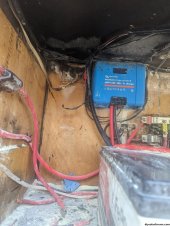This isn't specifically for the solar portion of the system, but this seems the best place to discuss fire safety of electrical enclosures in vehicle mounted systems.
I'm starting to plan out how I want to design my electrical enclosure to be as fire safe as possible and it's led me down a ton of rabbit holes.
One of the common methods to add fire protection capabilities is to use cement board as a fire stop. The issue is that it's hard to work with, and basically impossible to mount electronics to. I think what I've come up with is to make a cement board sandwich of 1/4 in plywood, 1/4 in cement board, and then another layer of 1/4 inch plywood. I'm thinking this will give me enough meat for screws to bite into to securely mount my components. Thoughts? The other option is a 1/2 inch plywood faced with 1/4 inch cement board.
The next challenge I'm having is that you can't just make your panel wall fire-resistant, there's plenty of flammable stuff all around your electronics. An easy solution is to make an enclosed box for everything, but now you have the issue of getting wires in/out, as well as ventilation to your sealed box. All of those openings are easy paths for flame and heat to escape.
Trying to solve that problem has led me down the path of intumescent fire protection. Intumescent fire materials are pretty amazing, they expand when exposed to fire and seal off cavities, graphite is a common material. I'm pretty sure you could buy some putty pads that are used around residential electrical junction boxes, poke some holes for your wiring, and then route them into the box. That should give you a good seal in the event of a fire.
The next problem was the ventilation holes though. At first I was looking at pipe collars designed for pvc pipe that are readily available and fairly cheap. You could use pvc for your ventilation hole and then install a pipe collar around it. These products are designed to physically crush the PVC to seal off the penetration though, and looking at some tests on youtube
it seems like it can take several (into the tens of) minutes before the hole is sealed which doesn't seem acceptable to me.
Then I stumbled on Vulcan Vents, which are a new product designed for wildfire protection. https://www.vulcanvents.com/vents/soffit-vents/ They use an intumescent honeycomb mesh to seal off airflow when exposed to fire. I think these are perfect solution for the problem, though they're not widely available yet. The biggest issue is getting the right size to match the box and any ventilation fans.
Does anyone see any flaws in my rough plan?
I'm starting to plan out how I want to design my electrical enclosure to be as fire safe as possible and it's led me down a ton of rabbit holes.
One of the common methods to add fire protection capabilities is to use cement board as a fire stop. The issue is that it's hard to work with, and basically impossible to mount electronics to. I think what I've come up with is to make a cement board sandwich of 1/4 in plywood, 1/4 in cement board, and then another layer of 1/4 inch plywood. I'm thinking this will give me enough meat for screws to bite into to securely mount my components. Thoughts? The other option is a 1/2 inch plywood faced with 1/4 inch cement board.
The next challenge I'm having is that you can't just make your panel wall fire-resistant, there's plenty of flammable stuff all around your electronics. An easy solution is to make an enclosed box for everything, but now you have the issue of getting wires in/out, as well as ventilation to your sealed box. All of those openings are easy paths for flame and heat to escape.
Trying to solve that problem has led me down the path of intumescent fire protection. Intumescent fire materials are pretty amazing, they expand when exposed to fire and seal off cavities, graphite is a common material. I'm pretty sure you could buy some putty pads that are used around residential electrical junction boxes, poke some holes for your wiring, and then route them into the box. That should give you a good seal in the event of a fire.
The next problem was the ventilation holes though. At first I was looking at pipe collars designed for pvc pipe that are readily available and fairly cheap. You could use pvc for your ventilation hole and then install a pipe collar around it. These products are designed to physically crush the PVC to seal off the penetration though, and looking at some tests on youtube
Then I stumbled on Vulcan Vents, which are a new product designed for wildfire protection. https://www.vulcanvents.com/vents/soffit-vents/ They use an intumescent honeycomb mesh to seal off airflow when exposed to fire. I think these are perfect solution for the problem, though they're not widely available yet. The biggest issue is getting the right size to match the box and any ventilation fans.
Does anyone see any flaws in my rough plan?





